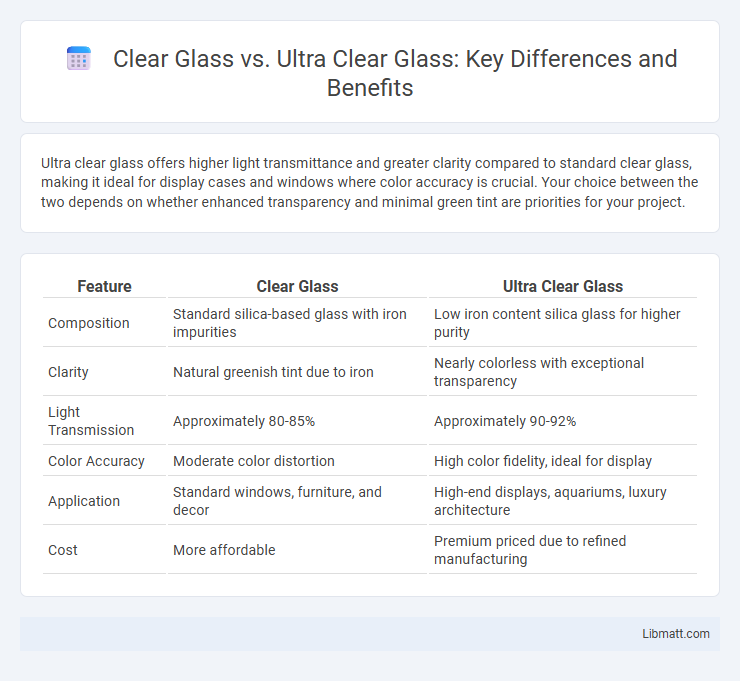Ultra clear glass offers higher light transmittance and greater clarity compared to standard clear glass, making it ideal for display cases and windows where color accuracy is crucial. Your choice between the two depends on whether enhanced transparency and minimal green tint are priorities for your project.
Table of Comparison
| Feature | Clear Glass | Ultra Clear Glass |
|---|---|---|
| Composition | Standard silica-based glass with iron impurities | Low iron content silica glass for higher purity |
| Clarity | Natural greenish tint due to iron | Nearly colorless with exceptional transparency |
| Light Transmission | Approximately 80-85% | Approximately 90-92% |
| Color Accuracy | Moderate color distortion | High color fidelity, ideal for display |
| Application | Standard windows, furniture, and decor | High-end displays, aquariums, luxury architecture |
| Cost | More affordable | Premium priced due to refined manufacturing |
Introduction to Glass Types
Clear glass typically contains a slight green tint due to iron content, affecting its color and light transmission, while ultra clear glass, also known as low-iron glass, offers higher transparency and minimal greenish hues. Ultra clear glass enhances visual clarity and color accuracy, making it ideal for applications requiring maximum light transmission such as display cases, aquariums, and high-end windows. The difference in iron content directly influences the optical properties and aesthetic qualities of these glass types.
What is Clear Glass?
Clear glass is a type of glass that contains a small amount of iron oxide, giving it a slight greenish tint when viewed from the edges. Ultra clear glass, also known as low-iron glass, is manufactured with minimal iron content to provide higher clarity and increased light transmission. Choosing ultra clear glass can enhance the appearance of your windows, showcases, or displays by offering a more true-to-color and transparent view.
What is Ultra Clear Glass?
Ultra clear glass, also known as low iron glass, contains significantly less iron content compared to standard clear glass, resulting in higher transparency and reduced greenish tint. This makes it ideal for applications requiring true color representation and enhanced clarity, such as aquariums, display cases, and high-end windows. You'll notice a brighter, more accurate view with ultra clear glass, elevating the aesthetic and functional quality of your projects.
Key Differences Between Clear Glass and Ultra Clear Glass
Clear glass contains a higher amount of iron oxide, which gives it a slight green tint and reduces light transmission, whereas ultra clear glass has significantly lower iron content, offering superior clarity and true color representation. Ultra clear glass provides enhanced transparency and brightness, making it ideal for displays, aquariums, and high-end architectural applications. The reduced iron content in ultra clear glass results in better UV resistance and improved optical quality compared to standard clear glass.
Light Transmission and Transparency
Ultra clear glass offers significantly higher light transmission, often exceeding 91%, compared to standard clear glass, which typically transmits around 84-90%. This enhanced transparency in ultra clear glass reduces the green tint found in traditional clear glass, providing more accurate color representation and a clearer, brighter view. For applications where maximum clarity and true color visibility are essential, such as picture framing or display cases, ultra clear glass is the superior choice for your needs.
Color and Visual Clarity Comparison
Clear glass exhibits a slight greenish tint due to iron content, which can affect color accuracy and visual clarity in applications requiring high transparency. Ultra clear glass has significantly reduced iron levels, resulting in minimal color distortion and superior light transmission, making it ideal for displays and architectural uses where true color representation is critical. The enhanced visual clarity of ultra clear glass ensures sharper images and more vibrant visuals compared to standard clear glass.
Applications of Clear Glass
Clear glass is widely used in residential and commercial windows, picture frames, and display cases due to its natural light transmission and affordability. It provides sufficient clarity for everyday applications but may have slight greenish tint affecting color accuracy. Your choice of clear glass is ideal for general applications where standard transparency and durability are required.
Applications of Ultra Clear Glass
Ultra clear glass is ideal for applications requiring maximum light transmission and minimal color distortion, such as museum display cases, high-end retail showcases, and picture framing. Its superior clarity enhances visual appeal and protects valuable items without compromising on transparency. When your project demands the purest glass quality, ultra clear glass outperforms standard clear glass in both performance and aesthetics.
Cost and Availability Factors
Clear glass is generally more affordable and widely available due to its standard production process and high demand in residential and commercial applications. Ultra clear glass, also known as low iron glass, commands a premium price because of its enhanced clarity and lower iron content, which reduces the green tint found in regular clear glass. You should consider ultra clear glass if transparency and aesthetic appeal are critical, but be prepared for higher costs and potentially limited availability depending on your supplier.
Choosing the Right Glass for Your Project
Clear glass offers standard clarity with a slight green tint due to iron content, making it suitable for everyday applications where cost-efficiency is important. Ultra clear glass features low iron content, providing superior transparency and minimal color distortion, ideal for projects requiring true color representation and maximum light transmission. Your choice depends on the visual quality and performance needed for your specific architectural or display project.
Clear glass vs ultra clear glass Infographic

 libmatt.com
libmatt.com